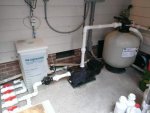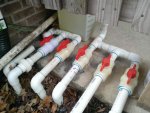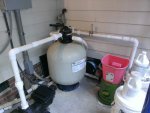After extensive testing, replacing the controller/freeze guard and communicating with U.S. Motors, the recommendation from U.S. Motors is to not count on the freeze guard that is built into the EcoTech EZ VS motor to protect your pool system.
The built-in freeze guard is supposed to cycle the pump on and off 30 minutes at a time, running at 30% flow, whenever the temperature drops below 40 degrees.
I don't close my pool in winter, and I'm located in Central North Carolina, so I need freeze protection.
After noticing that the freeze guard on my motor appeared to not be working, I contacted U.S. Motors. The customer service from U.S. Motors was excellent, and they sent me a replacement controller board to try, but the person I spoke with also acknowledged the possibility of a design defect. The replacement controller showed the same symptoms. In a follow-up e-mail after I reported my test results it was acknowledged that the built-in freeze guard is unlikely to function properly and that they are working on a redesign.
The problem is that the temperature sensor is in a sealed compartment close to the body of the motor, under the touchpad, which itself is under the touchpad cover. The result of this design is that the massive, metal body of the motor acts as a heat reservoir and the temperature sensor is sealed off from contact with the outside air.
Using electronic thermometers, and with the motor having been shut off for two hours, I measured the air temperature at 25 degrees, the temperature next to the motor at 32 degrees and the temperature under the touchpad cover at 35 degrees. The temperature in the sealed compartment under the touchpad and closer to the motor was presumably even warmer. Over the next two hours the air temperature rose to 36 degrees, the temperature next to the motor rose to 37 degrees and the temperature under the touchpad cover rose to 40 degrees. I checked the motor every 15 minutes, but the freeze guard never turned the motor on.
My only options are to install an external controller (with freeze guard) and the EcoTech EZ Interface Adapter Kit (at a cost of over $600) or to reprogram the pump to run continuously whenever temperatures are below freezing. U.S. Motors recommended the extended run times, which had been my conclusion also.
The built-in freeze guard is supposed to cycle the pump on and off 30 minutes at a time, running at 30% flow, whenever the temperature drops below 40 degrees.
I don't close my pool in winter, and I'm located in Central North Carolina, so I need freeze protection.
After noticing that the freeze guard on my motor appeared to not be working, I contacted U.S. Motors. The customer service from U.S. Motors was excellent, and they sent me a replacement controller board to try, but the person I spoke with also acknowledged the possibility of a design defect. The replacement controller showed the same symptoms. In a follow-up e-mail after I reported my test results it was acknowledged that the built-in freeze guard is unlikely to function properly and that they are working on a redesign.
The problem is that the temperature sensor is in a sealed compartment close to the body of the motor, under the touchpad, which itself is under the touchpad cover. The result of this design is that the massive, metal body of the motor acts as a heat reservoir and the temperature sensor is sealed off from contact with the outside air.
Using electronic thermometers, and with the motor having been shut off for two hours, I measured the air temperature at 25 degrees, the temperature next to the motor at 32 degrees and the temperature under the touchpad cover at 35 degrees. The temperature in the sealed compartment under the touchpad and closer to the motor was presumably even warmer. Over the next two hours the air temperature rose to 36 degrees, the temperature next to the motor rose to 37 degrees and the temperature under the touchpad cover rose to 40 degrees. I checked the motor every 15 minutes, but the freeze guard never turned the motor on.
My only options are to install an external controller (with freeze guard) and the EcoTech EZ Interface Adapter Kit (at a cost of over $600) or to reprogram the pump to run continuously whenever temperatures are below freezing. U.S. Motors recommended the extended run times, which had been my conclusion also.




